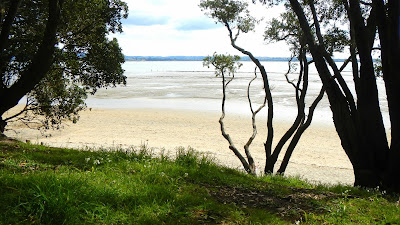The weather had changed... A strong wind had come up so the
most sheltered place was in the bush. It was not good for fishing.
The wind was blowing with force into the wharf...
So off I went with my botanist friend Janeen...
to look at plants... And interesting things.
We took lunch and sat in the grass amongst the gorse...
In the sun out of the wind. It was a great day.


This is native clematis... It has separate male
and female plants.

Coastal five finger ... houpara...
Grows to around 3m in sheltered sites but stays small and
shorn by strong coastal winds in exposed areas.

Pine trees... Provide food for the resident Kaka.
They rip the cones on the ground apart getting the pine seeds out.
Native forest regenerates below the pines.

Puriri seedling... This forest is regenerating to coastal
broadleaf forest. Puriri is found in more fertile soils.

Kawakawa... A small, densely branched aromatic
tree or shrub, grows up to 6 meters high. The flowers
are yellow golden spikes the female being shorter,
fatter and a brighter colour. They are edible and sweet...
Don't eat the hard black seeds inside... They are hot!

Green fruit on the kawakawa these will ripen up around January.

Rangiora... In flower.

Typical of regenerating broad leaved forest, rangiora,
hangehange, punga, and mingimingi... All seen here
together in this area of the forest.

The felty soft underside of rangiora leaves...
Known as bushman's toilet paper.

The knobbly twisted trunk of a kohekohe.
The knobby bits can sprout flowers direct from the trunk.

The Five-finger - puahou...
One of New Zealand's commonest native trees, found
from sea level to 760 meters in forests and open scrub,
from North Cape to Southland.

Small leaved coprosma regenerating below a canopy of kanuka.
The forest is beginning to grow again since the deer
have been removed around 10 years ago.
Grows to 15 meters high with a trunk 60 cm through.

Sundew... Native carnivorous plant that catches small insects and
digests them to obtain nitrogen and other nutrients.
A small herb growing no larger than 30cm.

A young manuka tree...
A component of the regenerating canopy. Manuka grows to 4 m
high all over New Zealand in forests and shrub-land.

Lindsaea linearis... A tiny creeping fern common
in poor soils.

Bush lawyer... Covered in hooks that will tie you up if
you walk into it. In the front a tiny leaved version of' Gumdiggers
soap - Pomaderris amoena.

This fallen tree trunk gets ripped to pieces by the Kaka...
A native forest parrot.

It's looking for protein...

Finds Huhu grubs and Weta and other insects...

In the soft rotting wood.

Motu Kaikoura has a recurring rat problem. They were
eradicated but can swim long distances... So swam back the 80km from
Great Barrier Island and re-established themselves.
There is an ongoing program to control them. These are rat motels,
they are attractive to rats. The rats will go in and investigate
as they are an enticing environment...

A combination of poisons and/or traps can be used in
the motels to kill the rats.
They are laid at all landing sites and track networks.
Rats will always be a problem for Motu Kaikoura and even
if Great Barrier Island becomes rat free there will still be a
need to have the 'motels' which provide both detection and control
functions should rats jump from a visiting boat.
For further information on rats and the Hauraki Gulf
look here.


























































